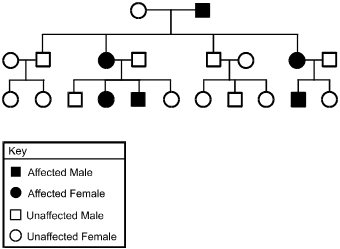Recommendation for individuals using a screenreader: please set your punctuation settings to "most."
Descriptive Statements:
- Analyze the synthesis, structure, and function of nucleic acids; gene structure and function and factors controlling gene expression; and the processes involved in protein synthesis.
- Analyze the types and causes of chromosomal and gene mutations, the consequences of these genetic changes, and the genetic basis of common disorders and diseases.
- Demonstrate knowledge of basic methods and applications of genetic engineering.
Sample Item:
Which of the following is the most likely cause of a base pair mutation?
- Sister chromatids fail to separate during meiosis.
- A small portion of one chromosome is added to another chromosome.
- A segment of a chromosome breaks, flips, and reinserts itself.
- The DNA is not accurately duplicated during replication.
Correct Response and Explanation (Show Correct ResponseHide Correct Response)
D. This question requires the examinee to analyze the types and causes
of chromosomal and gene mutations, the consequences of these genetic changes, and the
genetic basis of common disorders and diseases. Mutations that involve nucleotide base
pairs typically result from the substitution, insertion, or deletion of one or more
incorrect bases. These most commonly occur during the replication of DNA when the new
complementary strands are being produced.
Descriptive Statements:
- Analyze meiosis and fertilization and their roles in sexual life cycles.
- Analyze patterns of inheritance and the relationship between genotypic and phenotypic frequencies.
- Demonstrate knowledge of the chromosomal basis of inheritance and its relationship to observed inheritance patterns and of the characteristics of extranuclear inheritance in plants and animals.
- Solve genetics problems.
Sample Item:

The key provides symbols for Affected Male, Affected Female, Unaffected Male, and Unaffected Female. In the first generation, an unaffected female crosses with an affected male. This pair produces 4 offspring, which from left to right are an unaffected male who crosses with an unaffected female, an affected female who crosses with an unaffected male, an unaffected male who crosses with an unaffected female, and an affected female who crosses with an unaffected male. The first pair from the second generation produces 2 unaffected females. The second pair produces an unaffected male, an affected female, an affected male, and an unaffected female. The third pair produces an unaffected female, an unaffected male, and an unaffected female. The fourth pair produces an affected male and an unaffected female.
The pedigree above shows the sex-linked inheritance pattern of a gene. This pattern of
inheritance suggests the allele is:
- X-linked dominant.
- X-linked recessive.
- Y-linked dominant.
- Y-linked recessive.
Correct Response and Explanation (Show Correct ResponseHide Correct Response)
A. This question requires the examinee to analyze patterns of inheritance
and the relationship between genotypic and phenotypic frequencies. The allele cannot be
inherited as Y-linked, since females in the first generation of offspring express the trait.
If the trait is X-linked recessive, the affected females of the first generation must be
homozygous recessive and their offspring should show sex linkage, with the males affected
and the females unaffected. This is not the case. The pattern in the pedigree is consistent
with an X-linked dominant, however. The affected females of the first generation must be
heterozygous for the trait so the expression of the trait in their offspring would not show
sex linkage. This is the pattern in the pedigree.
Descriptive Statements:
- Demonstrate knowledge of population genetics (e.g., Hardy-Weinberg), the mechanisms of natural and artificial selection, and the sources and significance of variation in populations.
- Analyze evolutionary patterns and the mechanisms of speciation.
Sample Item:
The occurrence of similar features in organisms from different phylogenetic lineages can
be attributed to:
- gradualism.
- stabilizing selection.
- convergent evolution.
- uniformitarianism.
Correct Response and Explanation (Show Correct ResponseHide Correct Response)
C. This question requires the examinee to analyze evolutionary patterns
and the mechanisms of speciation. Organisms that are only distantly related may adapt by
developing similar characteristics in response to similar selective pressures. This is
known as convergent evolution.
Descriptive Statements:
- Demonstrate knowledge of the geologic history of Earth, current scientific theories on the origin of life, biologically significant events in Earth's history, and the fossil record.
- Demonstrate knowledge of the principles of biological classification, phylogenetic trees and their cladistic basis, evolutionary relationships of major groups of organisms, and evolution as a unifying principle in biology.
- Analyze different kinds of scientific evidence for evolution.
Sample Item:
Which of the following would provide the strongest evidence of a relatively close
evolutionary relationship between two species?
- Both species occupy similar niches in their respective ecological communities.
- Fossils of ancestors of both species are found in the same geographic area.
- The embryos of both species look almost identical until late stages of development.
- Both species use the same 20 amino acids to synthesize peptides and proteins.
Correct Response and Explanation (Show Correct ResponseHide Correct Response)
C. This question requires the examinee to analyze different kinds of
scientific evidence for evolution. Homologous patterns of development that appeared early
are shared by all members of an evolutionary lineage. Homologies shared by some but not
all members of a lineage suggest that the species sharing these homologies have a more
recent common ancestor than other members of the lineage. Thus species whose embryos
differ from each other only in the very late stages of development are likely to be more
closely related to each other than species that diverged at earlier stages of development.